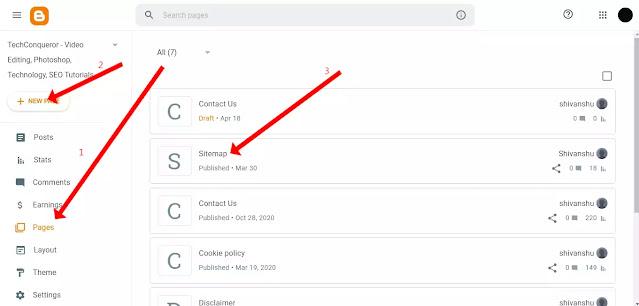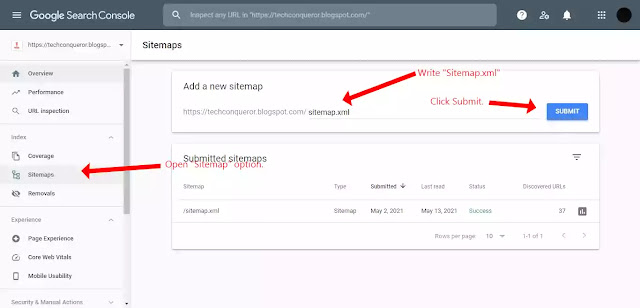Introduction
Whenever we are creating a site there are few things that should be on your webpage. There are pages that can increase your SEO and help your users to understand better about you and your site. Pages like About Us, Disclaimer, Privacy policy, Cookie policy, Contact Us and Sitemap are very important nowadays. These pages are also important for SEO and Adsense. In this article we will only learn about "Sitemap", How we can make an HTML Sitemap? and What is the difference between HTML & XML Sitemap? and many more.
WordPress makes this process easier, but in Blogger we have to do almost everything on our own. Making Sitemap in Blogger is not an easy task but it's not very hard too Just complicated. Follow the given steps. I will suggest you read the entire article for a better understanding of everything related to HTML & XML Sitemaps.
What is a Sitemap?
A Sitemap is a bundle of every single activity on your websites like any new post or Update. Almost every site has multiple posts and sometimes we do minor changes in the website or pages but have you ever wonder how Google finds out our activities, here the sitemap comes it tells google - Hey, Look at here there is a change, Send your bots to crawl this website. After when google finds out that yes there is a change in the site, Google sends its bots or crawlers to check this activity. Now you might be thinking why google won't crawl my site without a sitemap Google can do regular audits? There are millions and trillions of pages on the internet if Google crawls each one regularly then it will be so time and energy-consuming.
What is an HTML Sitemap?
Now you might understand, How sitemap is essential for Google But you might have a question that there is another sitemap which use to add to the menu section of your website, What was that?. Let me tell you there are 2 types of sitemaps used by people Generally. first HTML and Second XML, Both are different and important but both have the objective to explain your website.
HTML Sitemap
HTML sitemap is used to add to the home page of the site so users can understand your website without any problem. This sitemap is not meant for the Crawlers or Bots. HTML Sitemap is an important aspect to improve user experience especially if you have a site with hundreds of posts. Further, I will explain how you can create both sitemaps.
What is an XML Sitemap?
Previously we have talked about HTML sitemap which is mainly used for normal users or audiences. HTML sitemap is only made for users not for google to rank your content. Here XLM sitemap comes it's made up for only Search engine purposes,s not for humans. An HTML Sitemap tells users about your website, about your content. An XML Sitemap also does the same but this information is only made up for Bot's and Crawlers. This sitemap is not present on the home page. Both sitemaps are meant to understand the website.
How to make an HTML Sitemap?
To make an HTML sitemap make sure you have completely read this paragraph. You just have to comp, past, and edit the code.
Copy this code -
<script type="text/javascript">
var postTitle = new Array();
var postUrl = new Array();
var postPublished = new Array();
var postDate = new Array();
var postLabels = new Array();
var postRecent = new Array();
var sortBy = "titleasc";
var numberfeed = 0;
function bloggersitemap(a) {
function b() {
if ("entry" in a.feed) {
var d = a.feed.entry.length;
numberfeed = d;
ii = 0;
for (var h = 0; h < d; h++) {
var n = a.feed.entry[h];
var e = n.title.$t;
var m = n.published.$t.substring(0, 10);
var j;
for (var g = 0; g < n.link.length; g++) {
if (n.link[g].rel == "alternate") {
j = n.link[g].href;
break
}
}
var o = "";
for (var g = 0; g < n.link.length; g++) {
if (n.link[g].rel == "enclosure") {
o = n.link[g].href;
break
}
}
var c = "";
if ("category" in n) {
for (var g = 0; g < n.category.length; g++) {
c = n.category[g].term;
var f = c.lastIndexOf(";");
if (f != -1) {
c = c.substring(0, f)
}
postLabels[ii] = c;
postTitle[ii] = e;
postDate[ii] = m;
postUrl[ii] = j;
postPublished[ii] = o;
if (h < 10) {
postRecent[ii] = true
} else {
postRecent[ii] = false
}
ii = ii + 1
}
}
}
}
}
b();
sortBy = "titledesc";
sortPosts(sortBy);
sortlabel();
displayToc();
}
function sortPosts(d) {
function c(e, g) {
var f = postTitle[e];
postTitle[e] = postTitle[g];
postTitle[g] = f;
var f = postDate[e];
postDate[e] = postDate[g];
postDate[g] = f;
var f = postUrl[e];
postUrl[e] = postUrl[g];
postUrl[g] = f;
var f = postLabels[e];
postLabels[e] = postLabels[g];
postLabels[g] = f;
var f = postPublished[e];
postPublished[e] = postPublished[g];
postPublished[g] = f;
var f = postRecent[e];
postRecent[e] = postRecent[g];
postRecent[g] = f
}
for (var b = 0; b < postTitle.length - 1; b++) {
for (var a = b + 1; a < postTitle.length; a++) {
if (d == "titleasc") {
if (postTitle[b] > postTitle[a]) {
c(b, a)
}
}
if (d == "titledesc") {
if (postTitle[b] < postTitle[a]) {
c(b, a)
}
}
if (d == "dateoldest") {
if (postDate[b] > postDate[a]) {
c(b, a)
}
}
if (d == "datenewest") {
if (postDate[b] < postDate[a]) {
c(b, a)
}
}
if (d == "orderlabel") {
if (postLabels[b] > postLabels[a]) {
c(b, a)
}
}
}
}
}
function sortlabel() {
sortBy = "orderlabel";
sortPosts(sortBy);
var a = 0;
var b = 0;
while (b < postTitle.length) {
temp1 = postLabels[b];
firsti = a;
do {
a = a + 1
} while (postLabels[a] == temp1);
b = a;
sortPosts2(firsti, a);
if (b > postTitle.length) {
break
}
}
}
function sortPosts2(d, c) {
function e(f, h) {
var g = postTitle[f];
postTitle[f] = postTitle[h];
postTitle[h] = g;
var g = postDate[f];
postDate[f] = postDate[h];
postDate[h] = g;
var g = postUrl[f];
postUrl[f] = postUrl[h];
postUrl[h] = g;
var g = postLabels[f];
postLabels[f] = postLabels[h];
postLabels[h] = g;
var g = postPublished[f];
postPublished[f] = postPublished[h];
postPublished[h] = g;
var g = postRecent[f];
postRecent[f] = postRecent[h];
postRecent[h] = g
}
for (var b = d; b < c - 1; b++) {
for (var a = b + 1; a < c; a++) {
if (postTitle[b] > postTitle[a]) {
e(b, a)
}
}
}
}
function displayToc() {
var a = 0;
var b = 0;
while (b < postTitle.length) {
temp1 = postLabels[b];
document.write("");
document.write('<div class="post-archive"><h4>' + temp1 + '</h4><div class="ct-columns">');
firsti = a;
do {
document.write("<p>");
document.write('<a " href="' + postUrl[a] + '">' + postTitle[a] + "");
if (postRecent[a] == true) {
document.write(' - <strong><span>New!</span></strong>')
}
document.write("</a></p>");
a = a + 1
} while (postLabels[a] == temp1);
b = a;
document.write("</div></div>");
sortPosts2(firsti, a);
if (b > postTitle.length) {
break
}
}
}
</script>
<script src="https://techconqueror.blogspot.com/feeds/posts/summary?alt=json-in-script&max-results=9999&callback=bloggersitemap" type="text/javascript"></script> <!--Sitemap_Page Code Generated by https://techconqueror.blogspot.com-->
Go to >Blogger's Dashboard >Pages and Create a New Page as "Sitemap".
Change "Composed View" to "HTML View"
Past this code there.
At the bottom of the code, you have to add your Web site's URL and do not change anything else. Otherwise, your code might show some kind of error or even won't work.
How to make XML Sitemap For Blogger
Making XML Sitemap for blogger is pretty easy in blogger, Actually, you don't have to do much just enter your site's URL and add sitemap.xml Example - www.YourDomain.com/sitemap.xml. Now you got your sitemap, Whenever you update your website you can see a change there. XML Sitemap shows things like Last modified and many more you all post's URL are shown there.
How to make XML Sitemap for WordPress
Making a Sitemap in WordPress is very easy you just need to install a plugin called Yoast SEO In your WordPress CMS ( Content management system ). Yoast SEO is a pretty popular SEO plugin among WordPress users.
To install Yoast SEO in your WordPress, Open your WordPress, and on the left side there is a panel called "Plugins" on the subcategory, there is an option called "Add new" click on it, and on the search bar search Yoast. Click on the install button and then activate. Now you can see a new option in the control panel called "SEO". Go to "general" and click on "webmaster tools". copy your website's URL, Add new property use URL Prefix, Select HTML Tag open it and copy. Go to Yoast SEO and find an option called "Google verification code" paste the code there and click "Save changes" Go to Google search console and click "verify". Your Website has been verified and attached to Yoast SEO.
How to submit XML Sitemap to Google Search Console
If you successfully created your XML Sitemap then it's time to upload it on the Google search console. To verify that your sitemap is perfectly created check it, Search www.YourDomain.com/sitemap.xml. Go to Google search console and on the left side there is an option called "Sitemap" If you registered and verify your site in google search console then open the site map section and there your site's URL has shown just add "sitemap.xml" and click Submit. You have successfully uploaded your XML Sitemap.
FAQ - Sitemap
1. Does Sitemap Help To Get Better Ranks In Search Result?
Yes, XML Sitemap is compulsory and HTML Sitemap also Good for your Website. Personally, I Prefer to Add Sitemap On My Website.
2. Can I Include Images In Sitemap?
Yes, It totally depends on you It will help you to Gather The Audience from The Image section of the search result.
3. How Can I see the Sitemap of other websites?
For XML Sitemap Search a URL Example - www.SiteDomain.com/sitemap.xml. For HTML Go to the site's homepage and try to find the Sitemap section if the owner of the site added the sitemap then you can see the HTML Sitemap easily.
Conclusion
Finally, we reached the last level of the article, I hope you find this post informative. Before you leave the page and forget everything let's recall again what we have learned in this post. We have started with an introduction, Introduction is about what we will learn in this article. Then we understand what is exactly a Sitemap and deeply understand the difference between HTML & XML Sitemap. Then How to make HTML & XML Sitemap and How to Submit an XML Sitemap, Hey you can also check out this amazing Guide On SEO For Free.
Tell me in the comment section, What you like the most in this article and Does this article helps you?. We value your FeedBack. If you have any questions then you can just comment, for a fast reply DM Me on Twitter I will personally help you to understand the concept and creating the sitemap.






Comments
Post a Comment